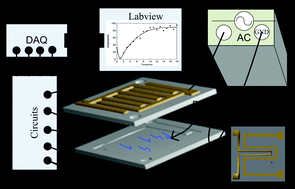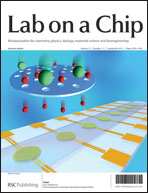Real-time monitoring of strand-displacement DNA amplification by a contactless electrochemical microsystem using interdigitated electrodes†
Abstract
This paper reports the design and implementation of a contactless conductivity detection system which combines a thermal control cell, a data processing system and an electrochemical (EC) cell for label-free isothermal nucleic acid amplification and real-time monitoring. The EC cell consists of a microchamber and interdigitated electrodes as the contactless conductivity biosensor with a cover slip as insulation. In our work, contactless EC measurements, the effects of trehalose on amplification, and chip surface treatment are investigated. With the superior performance of the biosensor, the device can detect the amount of pure DNA at concentrations less than 0.1 pg μl−1. The EC cell, integrated with a heater and a temperature sensor, has successfully implemented nicking-based strand-displacement amplification at an initial concentration of 2.5 μM and the yields are monitored directly (dismissing the use of probes or


 Please wait while we load your content...
Please wait while we load your content...